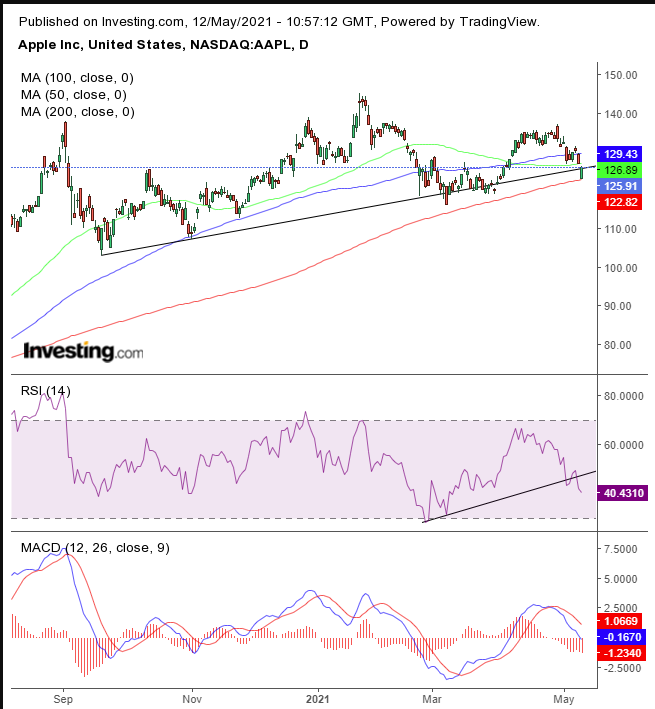Mounting inflationary concerns have been buffeting equities for some time now. Recently, the market sector that's suffered the most are high-flying technology stocks, after a stellar 2020.
Investors fear that if inflation heats up, the over-extended valuations of tech shares will no longer be supported by Federal Reserve accommodation and rates will have to be hiked no matter what the US central bank has been saying about lower-for-longer interest rates. With this worry in mind, investors have been repositioning portfolios to increase the weight of value assets, at the expense of growth sectors.
This recent phenomenon, of investors cycling in and out of tech shares based on their outlook for a reflation trade, has weighed on the tech-heavy NASDAQ 100, which is down 3.9% for the year. But it's most visible in the recent action of shares of iPhone maker Apple (NASDAQ:AAPL) which has been underperforming, and is down 5.1% YTD.
The weakness in technicals tells a cogent story:

Apple shares are struggling to not complete a large upward sloping H&S top. The rising neckline provided hopes the stock would continue to make new highs, but the slippage during March was the first sign of trouble.
That was followed by a lower peak on Apr. 29, which provided a second, negative signal. Finally, the price once again fell below the neckline, after which it found support by the 200 DMA and managed to close a hair above the neckline.
However, the bearish MACD and RSI both already fell below the uptrend line, ahead of the neckline, suggesting that risk is clearly to the downside. Moreover, the broadness of the pattern suggests heavy interest from traders, so if it completes and reverses, there will be a strong reaction.
If the pattern continues along its natural mechanics, the downside breakout will trigger shorts. As the short positions increase, and longs get stopped-out, demand will reduce.
Trading Strategies
Conservative traders should wait for a new low, below the Mar. 8 low of $116.21, which would establish a descending series of peaks and troughs, before risking a short.
Moderate traders would short with a close below the 200 DMA
Aggressive traders could short at will, if they accept the added risk of no trend confirmations, which would be the price to pay for the higher reward of beating the rest of the market. Money management is key.
Here is an example.
Trade Sample:
- Entry: $125
- Stop-Loss: $130
- Risk: $5
- Target: $110
- Reward: $15
- Risk:Reward Ratio: 1:3
Author's Note: This is a sample. You need to tailor a trade plan to your timing, budget and temperament. Till you learn how to do this, use our samples, but only for the purpose of learning, not for profit, or you’ll end up with neither. We guarantee it.
Which stock should you buy in your very next trade?
With valuations skyrocketing in 2024, many investors are uneasy putting more money into stocks. Unsure where to invest next? Get access to our proven portfolios and discover high-potential opportunities.
In 2024 alone, ProPicks AI identified 2 stocks that surged over 150%, 4 additional stocks that leaped over 30%, and 3 more that climbed over 25%. That's an impressive track record.
With portfolios tailored for Dow stocks, S&P stocks, Tech stocks, and Mid Cap stocks, you can explore various wealth-building strategies.
